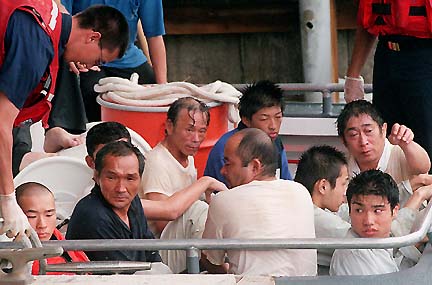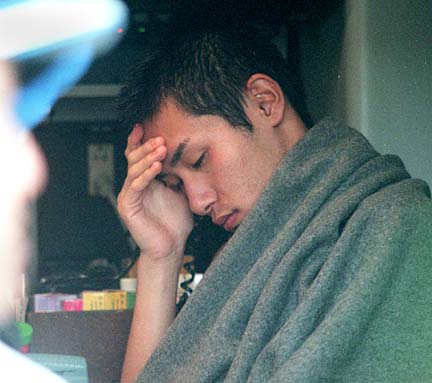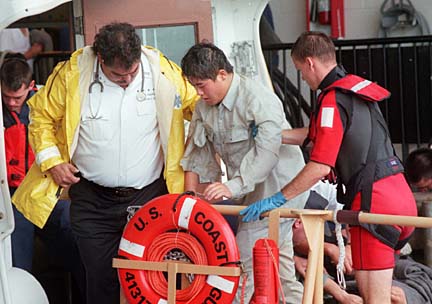Advertisement -- Click to support our sponsors.


‘I want to tell When a U.S. Navy submarine erupted through the ocean surface and struck the Ehime Maru fishing boat, Atsushi Kamado thought for the first time in his 16 years of life that he was going to die.
my parents
I am alive’
But the 16-year-old wonders,
‘Why did the submarine appear?’'Water is coming in'
The missing and injured
Uwajima agonizes
Surfacings always dangerous
By Leila Fujimori
Star-Bulletin"I was in a panic," Kamado said through a translator at his Ala Moana Hotel room this morning. "We had believed the boat was completely safe and never thought it would sink."
Kamado was one of 13 Uwajima Fisheries High School students aboard the 190-foot boat, about 10 miles from Diamond Head. Kamado was learning ship engineering, while others were studying fishing.
Kamado and ship engineer Sakichi Atsuta told the story of their harrowing brush with death. The two, still dressed in blue hospital garb, lost all their possessions.
After climbing to safety in a life raft, Kamado said, "I was extremely happy to know I was alive." Despite what he called the worst experience of his life, Kamado is not afraid to get back on a boat and plans to continue pursuing a career in marine engineering.
Still he wonders, "Why did the submarine appear?"

Luckily for Kamado, his boating safety training kicked in, and he recalled the first rule: Put on your life jacket and go up to the bridge.But when the submarine hit, Kamado was on the second level from the bottom of the boat. He said he heard a loud noise, the lights went out, and he saw smoke and oil coming from the engine room and water quickly flooding in.
There was no time to get his life jacket, so he raced up to the bridge.
Kamado hung on to the railing of the bridge, but he was sucked under the water as the boat went down.
He swallowed water, but when he looked up, a lifeboat was right above him at the surface. He swam up and grabbed on.
Oil got into his eyes but he was otherwise unharmed, he said.
"I want to tell my parents I am alive," said Kamado, the youngest of three children. But he had not had any contact with them this morning.
Nor did he know the fate of those still being searched for at sea: four students and two teachers, to whom he was very close. In fact, as Kamado spoke this morning with other students who were on the boat, he was not sure who was missing.

Atsuta, 50, who is also a prefecture official, said through a translator that he was washing his hands in the bathroom after lunch when he felt a huge jolt to the ship and heard a loud noise.With the water rapidly rising, he was forced up to the steering room and saw the front of the boat lifting up.
When Atsuta got up to the top level, he saw the submarine appear. A huge wave of water washed over the boat, and he was submersed.
Atsuta knew he had little time to act because when a boat begins to take on water, the water swirls like a whirlpool and can suck a person in.
He quickly swam upward and spotted a life raft, swam to it and hung on.
The boat was moving at about 30 mph when the submarine came up and hit the boat's engine room, said Atsuta.
He saw Akira Kagajyo, a ship engineer, come up from the engine room, covered with oil. Kagajyo suffered a broken rib.
But Kagajyo told Atsuta that the chief engineer and first engineer were both knocked out in the engine room.
Right after Kagajyo appeared, the boat went down, Atsuta said.

UWAJIMA, Japan -- Anxiety was yielding to anger and despair in this rural Japanese town as night fell today without word of four high school students and two teachers missing since a U.S. nuclear-powered submarine surfaced under their fishing boat off Oahu. Anxiety
gives way to anger
in hometownAssociated Press
After an agonizing day seeking information on those missing after yesterday's accident, the mayor of Uwajima vented his frustration.
"Common sense dictates that the rising submarine should have been watching for what was above it," Hiroshi Ishibashi said.
The families of the missing 17-year-old students gathered at the Uwajima Fisheries High School and expressed fears that U.S. officials were not doing enough to find their loved ones. Ehime Prefecture Gov. Moriyuki Kato relayed their concerns to the United States, prefectural official Yoshikatsu Matsuoka said.

For the townspeople who huddled around TV sets in restaurants and shops to watch news updates, concern mingled with anger."Come on, it's a nuclear submarine. They have to know what's going on around them," said company worker Fukushi Hamada, 63. "My goodness, what carelessness!"
The accident comes amid an uproar in Japan over sex crimes by U.S. servicemen on Okinawa. This past week, animosities were fueled when the top Marine in Okinawa, Lt. Gen. Earl Hailston, was reported to have sent his staff an email calling Okinawa legislators "nuts and a bunch of wimps." Hailston later apologized.
At the high school, which regularly sent students to Hawaii on training missions, sadness reigned.
"I had sent them off hoping that this would be a valuable learning experience, so I can't believe that this has happened," said vice principal Kazumitsu Joko, his voice shaking and his eyes tearing up.
The last word the school got from the boat came on Feb. 6, Joko said -- a telegraph reading, "All on schedule. Everybody's fine."
The U.S. government apologized to the parents today through Japan's Defense Agency, he said.